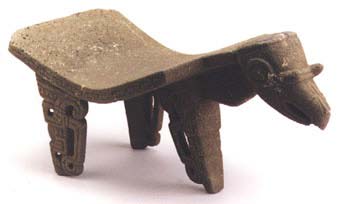Basalt Metate in the Form of a Bird, 300 CE - 700 CE
Basalt
12.5
PF.4261
Here is a magnificent stone sculpture of a bird that truly reflects the high degree of creativity, sophistication and master craftsmanship that exemplifies Costa Rican art at its golden age....
Here is a magnificent stone sculpture of a bird that truly reflects the high degree of creativity, sophistication and master craftsmanship that exemplifies Costa Rican art at its golden age. Immediately, one appreciates the amount of effort exerted by the artist in the execution of this work. The artist here has carefully modeled every feature of the bird's head and incorporated it into the functionality of the metate. Generally, the zoomorphic effigies on these metates may have been clan symbols or deity representations, or may have had other symbolic significance. Many metates show considerable wear from the grinding of a substance, probably maize, on their upper surface. Their use, however, was most likely restricted to ritual occasions. These objects are considered by some archaeologists to have been seats or "thrones," because of their frequent presence, unaccompanied by Manos, in high-ranking burials, and because of the representation, in ceramic figurines, of personages seated on similar artifacts, the ceramic seats, however, are almost always tetra pod, and probably depict wooden seats made for that purpose. Certain elite males might well have possessed metates for ritual food preparation; the metates would have been interred with them, along with other status items, such as jade pendants and ceremonial mace heads.
